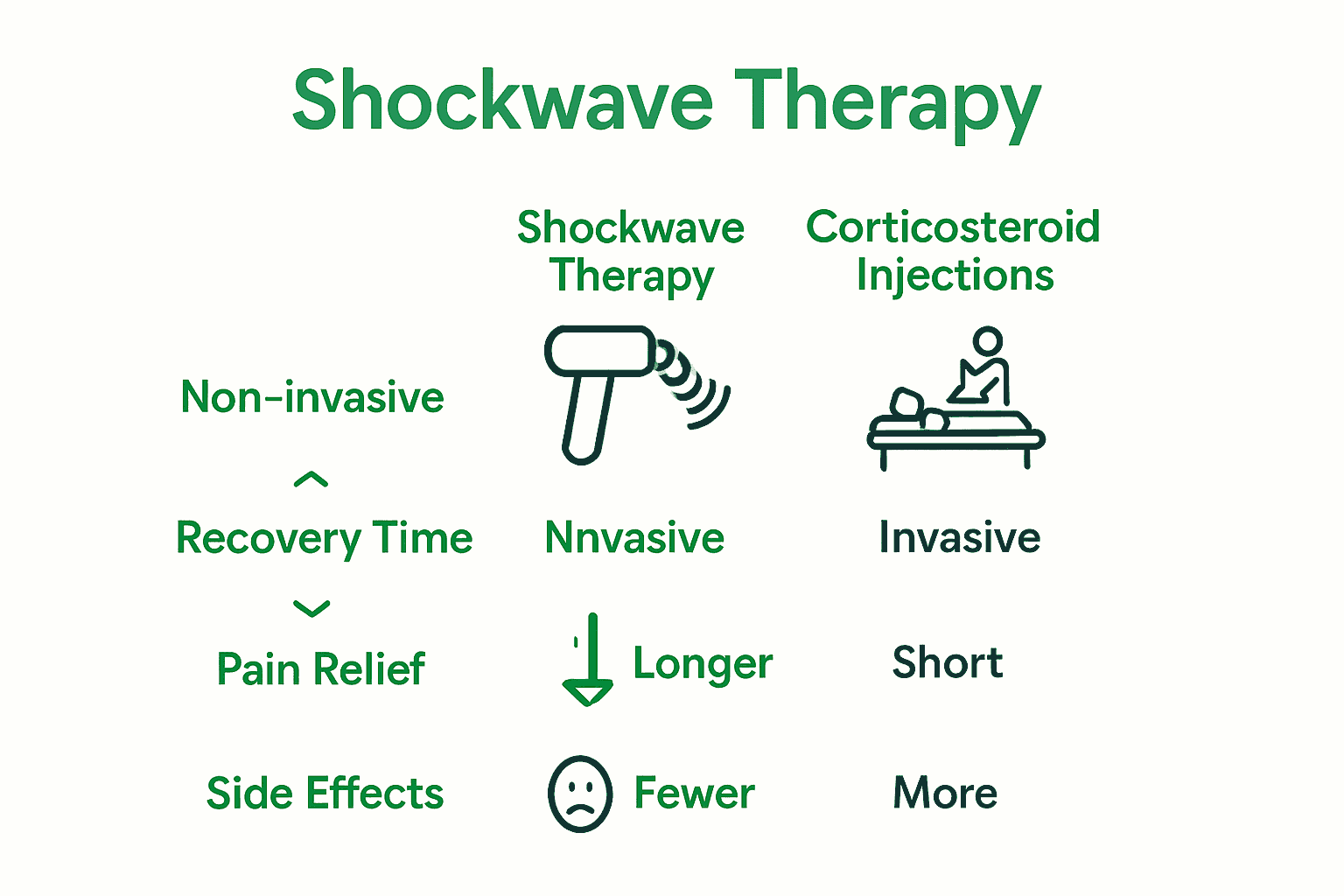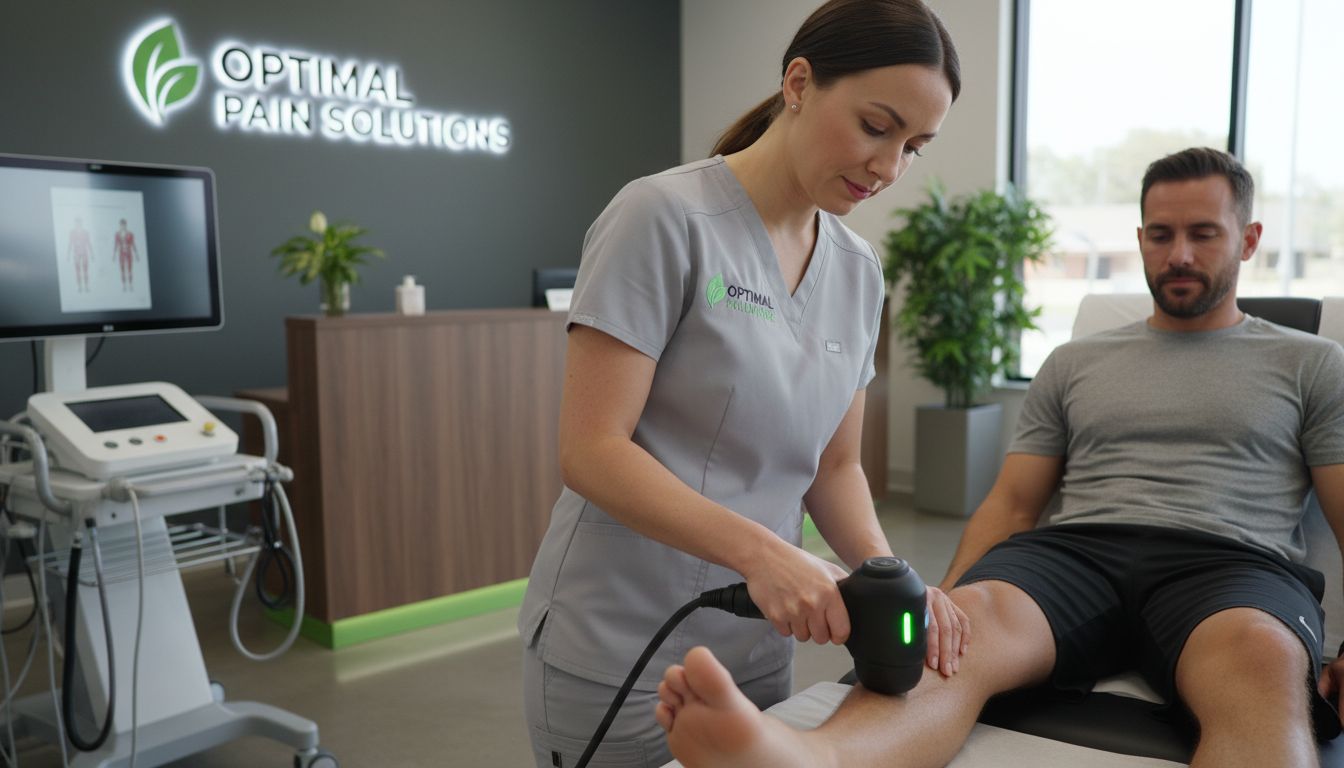More than 30 million adults suffer from chronic musculoskeletal pain, yet many overlook treatments that can speed recovery and ease discomfort. Shockwave therapy often gets dismissed due to common myths about pain or effectiveness, leading some people to miss out on real relief. Unpacking what shockwave therapy actually does, and clearing up these misconceptions, can help people make better choices about managing persistent pain.
Table of Contents
- Shockwave Therapy Explained and Common Misconceptions
- How Shockwave Therapy Works in Pain Relief
- Key Conditions Treated With Shockwave Therapy
- Safety, Risks, and Patients’ Expectations
- Comparing Shockwave Therapy With Alternative Treatments
Key Takeaways
| Point | Details |
|---|---|
| Innovative Treatment | Extracorporeal Shockwave Therapy (ESWT) is a non-invasive approach that uses high-energy acoustic waves to promote tissue healing and pain relief. |
| Overcoming Misconceptions | Many patients believe shockwave therapy is painful and only for chronic conditions, yet it is typically well-tolerated and effective for both acute and chronic issues. |
| Mechanism of Pain Relief | Shockwave therapy enhances blood circulation and cellular regeneration, while selectively interrupting pain signals, providing long-term relief for musculoskeletal conditions. |
| Comparison with Alternatives | It offers significant advantages over traditional treatments like corticosteroid injections, including a shorter recovery time and minimal side effects. |
Shockwave Therapy Explained and Common Misconceptions
Extracorporeal Shockwave Therapy (ESWT) represents an innovative non-invasive treatment designed to address musculoskeletal pain and promote natural healing. According to EBSCO, this advanced therapy uses high-energy acoustic waves to stimulate tissue repair and reduce discomfort in targeted areas.
Unlike traditional treatment methods, shockwave therapy delivers precise, high-intensity sound waves directly into problematic tissues. Physical Therapy research highlights that these waves penetrate deeper than standard ultrasound, triggering the body’s natural regenerative processes. This makes shockwave therapy particularly effective for conditions that have resisted conventional treatments.
Common misconceptions about shockwave therapy often prevent patients from exploring this powerful treatment option. Many people mistakenly believe that:
- The procedure is extremely painful
- It only works for chronic conditions
- It is identical to ultrasound therapy
- Recovery time is lengthy
In reality, shockwave therapy is a nuanced treatment that offers significant benefits with minimal discomfort. Patients typically experience a mild tingling sensation during the procedure, and sessions are relatively short, usually lasting 15-20 minutes. Moreover, the therapy can effectively treat both acute and chronic musculoskeletal conditions, making it a versatile option for pain management.

At Divergent Health, our experienced practitioners use focused shockwave pain therapy near me to provide personalized treatment plans tailored to each patient’s unique needs. By understanding the science behind shockwave therapy and dispelling common myths, patients can make informed decisions about their pain management and recovery strategies.
How Shockwave Therapy Works in Pain Relief
Extracorporeal Shockwave Therapy (ESWT) represents a sophisticated approach to pain management that goes far beyond traditional treatment methods. PubMed research reveals that this innovative therapy works by emitting high-intensity acoustic waves that trigger profound physiological responses within damaged tissues, effectively alleviating pain through multiple complex mechanisms.
At its core, shockwave therapy stimulates the body’s natural healing processes by targeting specific pain signaling pathways. According to PubMed research, the therapy strategically interacts with fascia nociceptors, creating a selective disruption of sensory nerve fibers. This precise intervention leads to long-lasting analgesia, making it particularly effective for chronic musculoskeletal conditions that have resisted conventional treatments.
The pain relief mechanism of shockwave therapy involves several key biological processes:
- Enhanced Blood Circulation: Acoustic waves promote increased blood flow to targeted areas
- Cellular Regeneration: Stimulates cell proliferation and tissue repair
- Inflammation Reduction: Decreases inflammatory responses in damaged tissues
- Nerve Fiber Modulation: Selectively interrupts pain signal transmission
By targeting the root causes of pain rather than merely masking symptoms, Shockwave Pain Therapy Near Me offers patients a scientifically grounded approach to healing.
The therapy’s ability to trigger natural regenerative processes makes it a powerful alternative to invasive surgical interventions, providing hope for individuals struggling with persistent musculoskeletal pain.
Key Conditions Treated With Shockwave Therapy
Shockwave therapy has emerged as a versatile treatment option for a wide range of musculoskeletal conditions, offering hope to patients struggling with chronic pain and limited mobility. NCBI research highlights its particular effectiveness in treating lower extremity orthopedic disorders, providing a non-invasive alternative for those seeking relief from persistent musculoskeletal challenges.
The therapy demonstrates remarkable success in addressing several specific conditions. According to BMC Musculoskeletal Disorders, radial shockwave therapy has shown significant potential in treating myofascial pain syndrome, particularly in the neck region. This breakthrough offers new possibilities for patients who have exhausted traditional treatment methods.
Key conditions effectively treated by shockwave therapy include:
- Plantar Fasciitis: Chronic heel pain and inflammation
- Achilles Tendinopathy: Painful condition affecting the Achilles tendon
- Patellar Tendinopathy: Knee tendon injuries common in athletes
- Myofascial Pain Syndrome: Chronic muscle pain, especially in neck and shoulder regions
- Sports-Related Injuries: Muscle and tendon strains
- Chronic Soft Tissue Conditions: Persistent muscle and joint pain
For those struggling with persistent musculoskeletal issues, plantar fasciitis treatments represent just one of the many specialized approaches available. By targeting the root causes of pain and promoting natural healing, shockwave therapy offers a promising solution for patients seeking long-term relief and improved mobility without invasive surgical interventions.
Safety, Risks, and Patients’ Expectations
Shockwave therapy represents a sophisticated non-invasive treatment approach that prioritizes patient safety while offering significant pain management potential. Patients considering this innovative therapy can expect a carefully monitored procedure designed to minimize risks and maximize therapeutic outcomes.
During the treatment process, patients will experience a series of controlled acoustic wave interventions. The procedure typically involves mild sensations of pressure and occasional tingling, which most individuals find tolerable. While some temporary discomfort may occur, serious complications are extremely rare when the therapy is administered by trained healthcare professionals who understand precise application techniques.
Potential side effects and considerations include:
- Temporary Skin Reddening: Minor skin reaction at treatment site
- Mild Bruising: Light bruising may occur in treated area
- Temporary Increased Sensitivity: Slight heightened sensation around treatment zone
- Minimal Discomfort: Mild pressure or tingling during procedure
- Short Recovery Period: Most patients resume normal activities immediately
Sports Injury Treatment patients often find shockwave therapy particularly appealing due to its minimal invasiveness and rapid recovery timeline. By setting realistic expectations and working closely with experienced practitioners, patients can approach the treatment with confidence, understanding that the therapy represents a targeted, scientifically-backed approach to addressing chronic pain and promoting natural healing processes.
Comparing Shockwave Therapy With Alternative Treatments
NCBI research reveals that shockwave therapy stands out as a sophisticated alternative to traditional pain management approaches, offering unique advantages over conventional treatments like corticosteroid injections and standard physical therapy protocols. Unlike invasive interventions, this innovative therapy provides a non-surgical option for patients seeking targeted pain relief and tissue regeneration.
When comparing treatment modalities, shockwave therapy demonstrates remarkable distinctions. According to BMC Musculoskeletal Disorders, systematic reviews indicate significant improvements in imaging outcomes, suggesting its potential superiority in addressing musculoskeletal conditions where traditional treatments might fall short.
Key comparative differences include:
Here’s a comparison of shockwave therapy with traditional treatment approaches:
| Feature | Shockwave Therapy | Corticosteroid Injections | Standard Physical Therapy |
|---|---|---|---|
| Invasiveness | Non-invasive | Minimally invasive | Non-invasive |
| Recovery Time | Short Immediate activity |
Variable May require rest |
Short Immediate activity |
| Pain Relief Duration | Long-lasting | Often short-term | Variable |
| Side Effects | Mild Temporary Rare |
Potential systemic effects | Minimal |
| Mechanism | Stimulates natural healing | Reduces inflammation Masks pain |
Physical rehabilitation |
| Targeted Treatment | High precision | Localized | Generalized exercises |
- Non-Invasive: Unlike surgical interventions
- Minimal Side Effects: Compared to pharmaceutical treatments
- Targeted Healing: More precise than generalized approaches
- Faster Recovery: Shorter downtime than surgical alternatives
- Natural Regeneration: Stimulates body’s healing mechanisms
Laser Therapy for Inflammation represents another innovative treatment option that, like shockwave therapy, focuses on non-invasive healing strategies. While each treatment has its unique strengths, shockwave therapy continues to emerge as a promising solution for patients seeking advanced, scientifically-backed pain management techniques that prioritize natural healing and minimal intervention.

Discover Lasting Pain Relief with Personalized Shockwave Therapy
Living with persistent musculoskeletal pain can be frustrating and discouraging. If you have explored various treatments without success, it might be time to consider advanced solutions like Extracorporeal Shockwave Therapy that stimulate natural healing and target the root causes of pain. This guide explains how shockwave therapy offers a non-invasive, effective option that reduces discomfort, supports tissue repair, and can enhance your quality of life.

Take control of your pain management journey today by exploring innovative therapies at Divergent Health. Our Calgary-based clinic provides expert shockwave therapy and a wide range of evidence-based treatments tailored to your unique needs. Visit our Uncategorized page to learn more about our comprehensive services and start your path toward improved mobility and wellness. Don’t wait for pain to dictate your life. Schedule a consultation now and experience the benefits of modern, personalized care.
Frequently Asked Questions
What is Shockwave Therapy?
Shockwave Therapy, or Extracorporeal Shockwave Therapy (ESWT), is a non-invasive treatment that uses high-energy acoustic waves to stimulate tissue repair and reduce musculoskeletal pain.
How does Shockwave Therapy work in pain relief?
Shockwave Therapy works by emitting acoustic waves that trigger physiological responses, enhancing blood circulation, reducing inflammation, stimulating cellular regeneration, and modulating nerve fibers to provide long-lasting pain relief.
What conditions can be treated with Shockwave Therapy?
Shockwave Therapy effectively treats various conditions, including plantar fasciitis, Achilles tendinopathy, myofascial pain syndrome, and sports-related injuries, offering a non-invasive alternative for chronic pain management.
Is Shockwave Therapy painful?
Most patients experience mild sensations such as pressure or tingling during the procedure, which is generally tolerable. Serious complications are rare, and recovery time is short, allowing patients to resume normal activities shortly after treatment.
Recommended
- Shockwave Pain Therapy Near Me – Divergent Health Calgary
- Focused Shockwave Pain Therapy near me – Divergent Health Calgary
- 4 Different Types of Headaches and Their Treatment – Pain and Injury Clinic in Calgary, AB – Divergent Health
- How Does Laser Therapy Help Treat Inflammation? – Pain and Injury Clinic in Calgary, AB – Divergent Health

